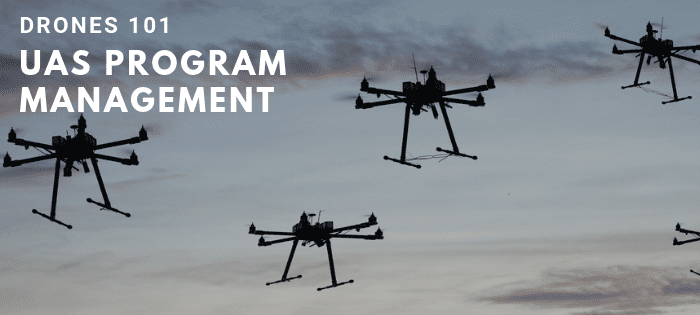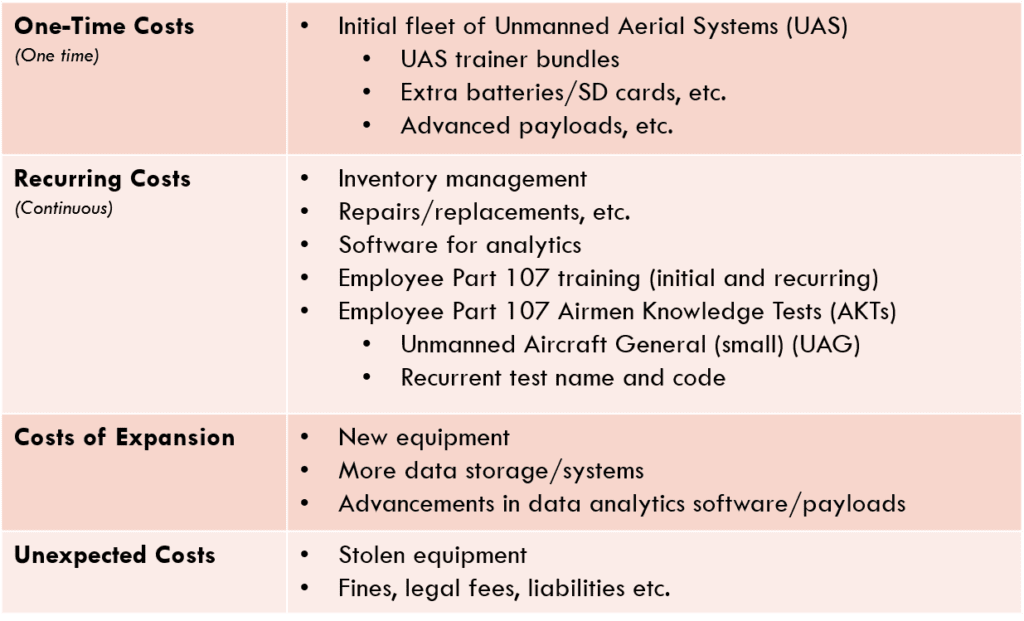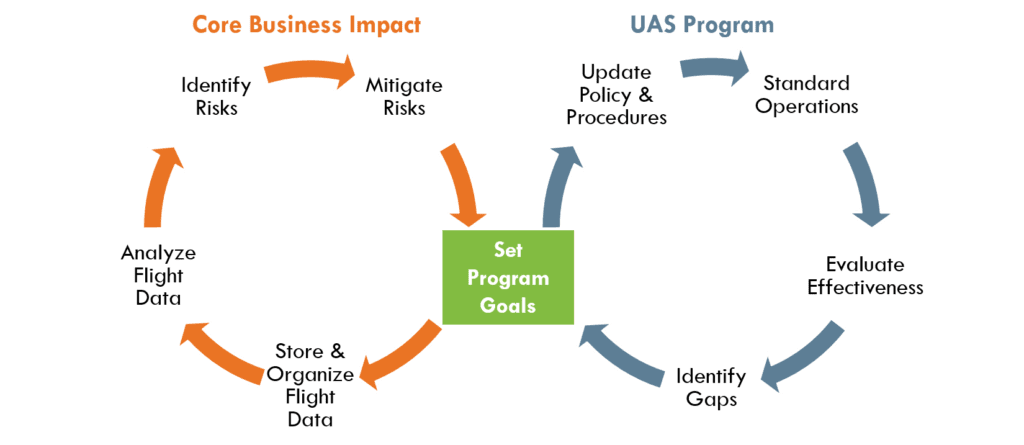
Environment / Quality / Safety / Technology Enabled Business Solutions
Comments: No Comments
This is the fourth article in Kestrel’s Drones 101 series.
Drones can reduce risk in commercial operations, but it is important to acknowledge that they can also introduce risk through damage to property, safety incidents, loss of UAS assets, and legal and regulatory issues. And without a planned, organized UAS program, your risks increase significantly.
Why UAS Programs Fail
Why do some drone programs fail? Both large and small companies can establish safe and reliable drone programs, but a solid foundation early in the process is essential for success. Lack of planning will (at best) add up to a short-lived drone program or (at worst) cause your company undue risk or injury.
In short, buying and operating UAS equipment without a plan in place can lead to:
- Sunk costs
- Delayed success
- Safety incidents
- Service delays
- Employee injury
- Loss of financial backing legal and regulatory issues
Foundations of a Drone Program
A solid, sustainable UAS program starts with consideration of a handful of essential elements, as discussed below.
Financial Resources. Your program needs to consider cost. Not only will you need to create a budget for approval, but you will want to be aware of and able to accurately communicate costs and have a basis for arriving at a return on your investment. A good approach is to categorize your costs into one-time capital costs; recurring costs related to equipment, software and pilots; and costs for expansion.
 Incidentally, the cost to take the Part 107 Airmen Knowledge Test is $150 per attempt. A prep course online will run about $200 -$300. To stay current, pilots are required to take a test every two years, which also costs $150 per attempt
Incidentally, the cost to take the Part 107 Airmen Knowledge Test is $150 per attempt. A prep course online will run about $200 -$300. To stay current, pilots are required to take a test every two years, which also costs $150 per attempt
The key point is to understand your costs, budget for them, and put the drone program in the best position to be funded as needed.
Cross-Functional Strategy
Ideally, you want a team of people with different functional expertise working toward the common goal of helping the company achieve the benefits associated with a drone program. Consider involving individuals in program management, operations management, legal/compliance, human resources, information technology, and others.
Depending on how large your organization is, the team may be one or two individuals who wear many hats and juggle responsibilities. Larger organizations may expand the size and functions beyond this example. Think about how your organization might function:
- Is your program manager and operations manager the same person?
- Which of the following is the highest priority for your legal team: data security, regulatory compliance, or employee safety?
- Do you have the in-house IT resources to support the technical needs of a UAS program?
You don’t necessarily have to have a large team, but you do need to consider how you’ll cover all the related functions and responsibilities.
UAS Program Operations Manual
A UAS program operations manual – whether it is a paper binder or an online resource – is a must. It’s important that you have well thought-out policies and procedures, standard practices, and emergency plans. It is just as important that all your pilots and team members are familiar with them, so everyone is operating from the same playbook.
Your operations manual should lay out expectations and company-approved applications of UAS technology. In general, it should include the following:
- Policies, procedures, standard operating practices, safety programs
- Identified risks, hazards, and emergency situations; mitigation measures
- Data management and documentation requirements
- How/when to verify federal and state regulations for UAS technology
- Employment terms/contracts (employee, contractor, vendor)
Integrated Systems
Much like the cross-functional team we just covered, your internal business systems should include drone program-related tasks and subsystems. These should be integrated into the normal flow of business in your organization.
If your company operates under an ISO-style management system (e.g., ISO 9001, ISO 140001, or ISO 45001), you have the opportunity to align and integrate systems with your existing program and take advantage of the plan-do-check-act cycle associated with ISO management systems. Consider systems for communication, inventory management, data management, employee management, and technical support, among others.
Measurable Goals
It’s a standard exercise in any management system to set measurable goals and track progress against them. The same standard should be upheld for drone program management. Setting metrics and evaluation methods will allow you to show the value of your UAS program.
- First, set goals for the drone program overall. This may include:
- UAS pilot effectiveness (e.g., safety, training status, reportables, compliance)
- Effectiveness of policies and procedures
- ROI of the UAS program (e.g., money saved, time saved, fewer injuries, lower workers compensation rates)
- Second, set goals to measure the impact of the drone program on your core business.
- How will UAS enhancements change/improve existing company performance metrics?
- For example, can you move from biannual inventory of resources to quarterly due to ease of inspections? Or monitor high-risk bridges, wind turbines, etc. every 3 months?
- Set or adjust thresholds based on the knowledge you gain from UAS enhancements.
Plan for Continuous Improvement
Finally, you should have a plan for continuous improvement. An effective plan will follow the classic management system plan-do-check-act cycle to drive improvement in not only the drone program, but in the core business as well.
In the diagram below, drone program goals related to improved policies and procedures lead to standard operations practices. The effectiveness of these actions is evaluated, gaps are identified, and additional goals are set. As an example, let’s say one of those policies and procedures is to address how we manage flight data. A goal is set, the procedure is examined, previously unidentified risks are discovered, and mitigation measures are put in place in the policies, procedures and SOPs.
 Key Takeaways
Key Takeaways
Drones can enhance your current business operations by reducing the time and safety risks involved with routine tasks, but they bring with them their own operational and regulatory considerations. To help ensure your drone program’s success:
- Establish a solid foundation early.
- Establish policies and procedures to reduce inefficiencies and ensure compliance.
- Create systems to reliably track the location, status, and condition of your drone fleet – regardless of size.
- Establish systems to track and manage the training and certification status of all employees or contractors in the UAS program.
- Monitor and manage maintenance and repairs/replacements of the drone fleet to reduce operational risks of drone failure during flight and to ensure that employees are operating their drones safely and efficiently.
- Develop systems to manage and organize huge quantities of data from drone flights so you can easily find footage/stills and leverage the data gathered.
- Design and implement integrated software systems to prevent liabilities, loss of ROI, and safety risks.
Learn more about Kestrel’s UAS Program Management services. Be sure to check out the entire Drones 101 series:
- Terminology & Technology
- Applicability
- Regulations
- Drone Program Management
- Top 6 Tips for Managing Your Drone Program
